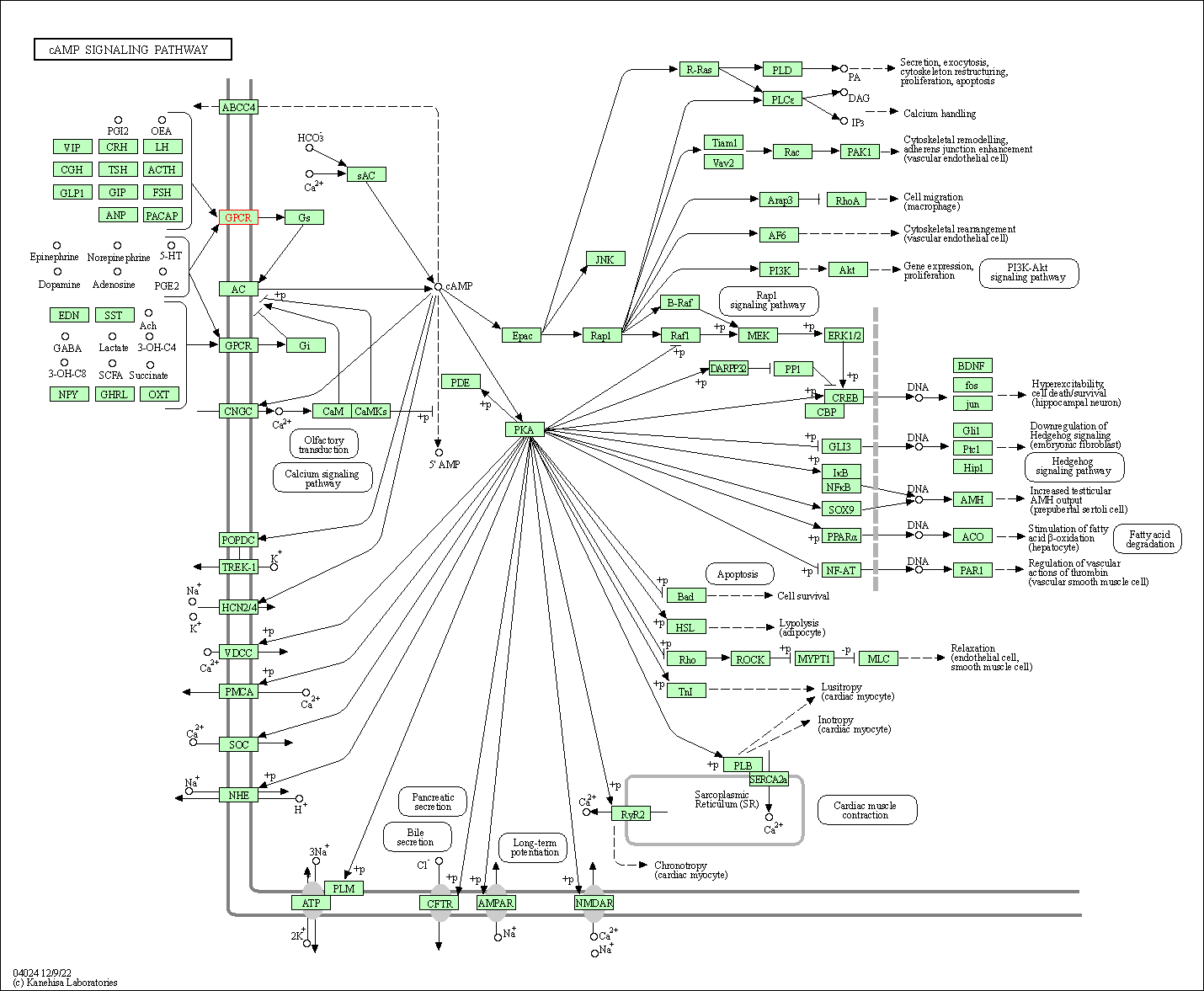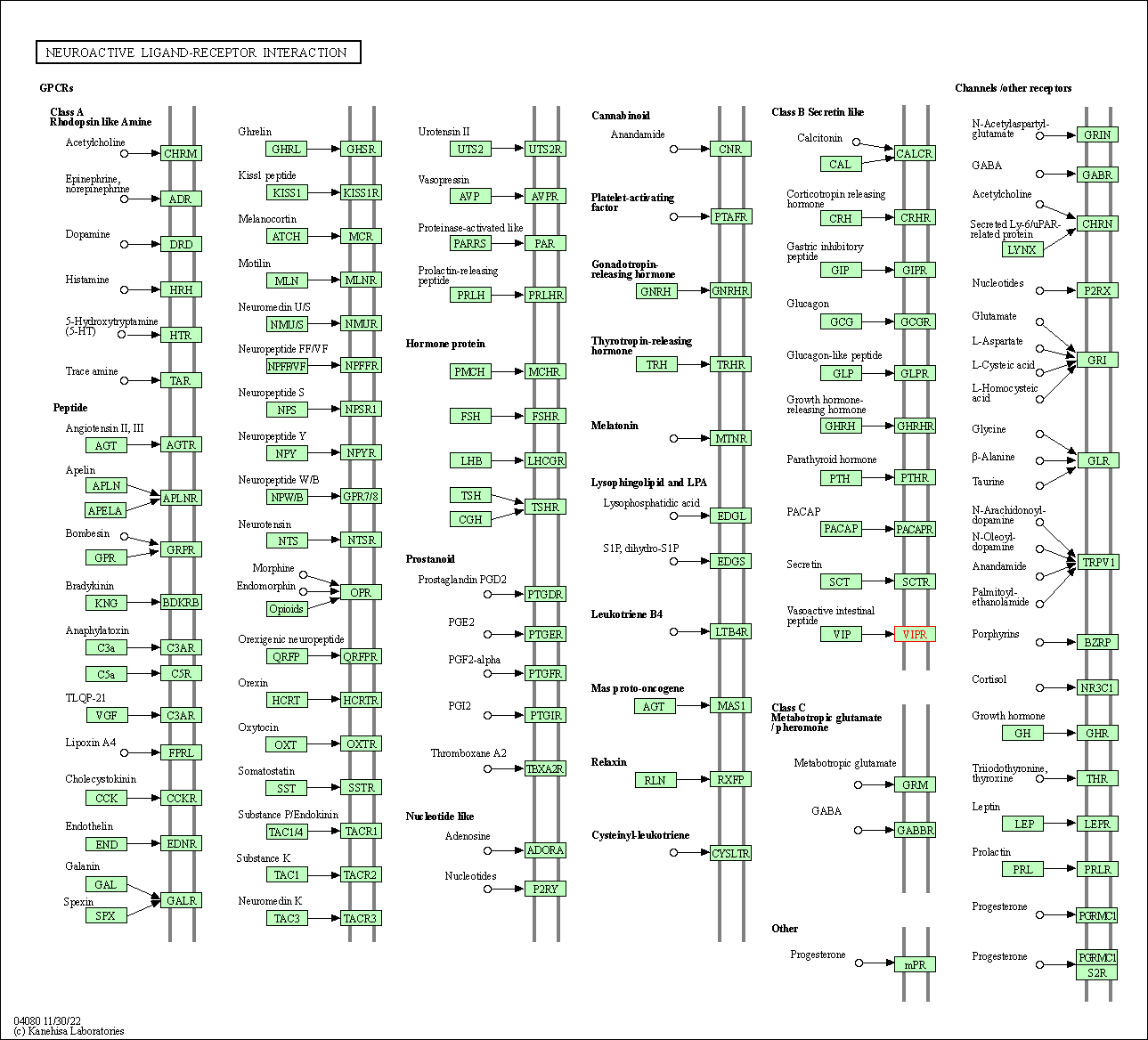Target Information
| Target General Information | Top | |||||
|---|---|---|---|---|---|---|
| Target ID |
T06182
(Former ID: TTDI02208)
|
|||||
| Target Name |
Helodermin-preferring VIP receptor (VIPR2)
|
|||||
| Synonyms |
Vasoactive intestinal polypeptide receptor 2; VPAC2; VIPR2; VIP-R-2; Pituitary adenylate cyclase-activating polypeptide typeIII receptor; PACAP-R3; PACAP-R-3; PACAP type III receptor
Click to Show/Hide
|
|||||
| Gene Name |
VIPR2
|
|||||
| Target Type |
Clinical trial target
|
[1] | ||||
| Disease | [+] 6 Target-related Diseases | + | ||||
| 1 | Heart failure [ICD-11: BD10-BD1Z] | |||||
| 2 | Pulmonary hypertension [ICD-11: BB01] | |||||
| 3 | Cardiomyopathy [ICD-11: BC43] | |||||
| 4 | Chronic obstructive pulmonary disease [ICD-11: CA22] | |||||
| 5 | Hypertension [ICD-11: BA00-BA04] | |||||
| 6 | Muscular dystrophy [ICD-11: 8C70] | |||||
| Function |
This is a receptor for VIP as well as PACAP-38 and -27,the activity of this receptor is mediated by G proteins which activate adenylyl cyclase. Can be coupled to phospholipase C.
Click to Show/Hide
|
|||||
| BioChemical Class |
GPCR secretin
|
|||||
| UniProt ID | ||||||
| Sequence |
MRTLLPPALLTCWLLAPVNSIHPECRFHLEIQEEETKCAELLRSQTEKHKACSGVWDNIT
CWRPANVGETVTVPCPKVFSNFYSKAGNISKNCTSDGWSETFPDFVDACGYSDPEDESKI TFYILVKAIYTLGYSVSLMSLATGSIILCLFRKLHCTRNYIHLNLFLSFILRAISVLVKD DVLYSSSGTLHCPDQPSSWVGCKLSLVFLQYCIMANFFWLLVEGLYLHTLLVAMLPPRRC FLAYLLIGWGLPTVCIGAWTAARLYLEDTGCWDTNDHSVPWWVIRIPILISIIVNFVLFI SIIRILLQKLTSPDVGGNDQSQYKRLAKSTLLLIPLFGVHYMVFAVFPISISSKYQILFE LCLGSFQGLVVAVLYCFLNSEVQCELKRKWRSRCPTPSASRDYRVCGSSFSRNGSEGALQ FHRGSRAQSFLQTETSVI Click to Show/Hide
|
|||||
| 3D Structure | Click to Show 3D Structure of This Target | AlphaFold | ||||
| Drugs and Modes of Action | Top | |||||
|---|---|---|---|---|---|---|
| Clinical Trial Drug(s) | [+] 2 Clinical Trial Drugs | + | ||||
| 1 | PB1046 | Drug Info | Phase 2 | Heart failure | [2] | |
| 2 | RG-7103 | Drug Info | Phase 1 | Chronic obstructive pulmonary disease | [3] | |
| Mode of Action | [+] 2 Modes of Action | + | ||||
| Agonist | [+] 4 Agonist drugs | + | ||||
| 1 | PB1046 | Drug Info | [1] | |||
| 2 | RG-7103 | Drug Info | [4] | |||
| 3 | helodermin | Drug Info | [5] | |||
| 4 | PACAP-27 | Drug Info | [6] | |||
| Modulator | [+] 1 Modulator drugs | + | ||||
| 1 | PB-1120 | Drug Info | [7] | |||
| Cell-based Target Expression Variations | Top | |||||
|---|---|---|---|---|---|---|
| Cell-based Target Expression Variations | ||||||
| Different Human System Profiles of Target | Top |
|---|---|
|
Human Similarity Proteins
of target is determined by comparing the sequence similarity of all human proteins with the target based on BLAST. The similarity proteins for a target are defined as the proteins with E-value < 0.005 and outside the protein families of the target.
A target that has fewer human similarity proteins outside its family is commonly regarded to possess a greater capacity to avoid undesired interactions and thus increase the possibility of finding successful drugs
(Brief Bioinform, 21: 649-662, 2020).
Human Tissue Distribution
of target is determined from a proteomics study that quantified more than 12,000 genes across 32 normal human tissues. Tissue Specificity (TS) score was used to define the enrichment of target across tissues.
The distribution of targets among different tissues or organs need to be taken into consideration when assessing the target druggability, as it is generally accepted that the wider the target distribution, the greater the concern over potential adverse effects
(Nat Rev Drug Discov, 20: 64-81, 2021).
Human Pathway Affiliation
of target is determined by the life-essential pathways provided on KEGG database. The target-affiliated pathways were defined based on the following two criteria (a) the pathways of the studied target should be life-essential for both healthy individuals and patients, and (b) the studied target should occupy an upstream position in the pathways and therefore had the ability to regulate biological function.
Targets involved in a fewer pathways have greater likelihood to be successfully developed, while those associated with more human pathways increase the chance of undesirable interferences with other human processes
(Pharmacol Rev, 58: 259-279, 2006).
Biological Network Descriptors
of target is determined based on a human protein-protein interactions (PPI) network consisting of 9,309 proteins and 52,713 PPIs, which were with a high confidence score of ≥ 0.95 collected from STRING database.
The network properties of targets based on protein-protein interactions (PPIs) have been widely adopted for the assessment of target’s druggability. Proteins with high node degree tend to have a high impact on network function through multiple interactions, while proteins with high betweenness centrality are regarded to be central for communication in interaction networks and regulate the flow of signaling information
(Front Pharmacol, 9, 1245, 2018;
Curr Opin Struct Biol. 44:134-142, 2017).
Human Similarity Proteins
Human Tissue Distribution
Human Pathway Affiliation
Biological Network Descriptors
|
|
|
There is no similarity protein (E value < 0.005) for this target
|
|
Note:
If a protein has TS (tissue specficity) scores at least in one tissue >= 2.5, this protein is called tissue-enriched (including tissue-enriched-but-not-specific and tissue-specific). In the plots, the vertical lines are at thresholds 2.5 and 4.
|
| KEGG Pathway | Pathway ID | Affiliated Target | Pathway Map |
|---|---|---|---|
| cAMP signaling pathway | hsa04024 | Affiliated Target |

|
| Class: Environmental Information Processing => Signal transduction | Pathway Hierarchy | ||
| Neuroactive ligand-receptor interaction | hsa04080 | Affiliated Target |

|
| Class: Environmental Information Processing => Signaling molecules and interaction | Pathway Hierarchy | ||
| Degree | 2 | Degree centrality | 2.15E-04 | Betweenness centrality | 3.65E-06 |
|---|---|---|---|---|---|
| Closeness centrality | 1.56E-01 | Radiality | 1.22E+01 | Clustering coefficient | 0.00E+00 |
| Neighborhood connectivity | 3.50E+00 | Topological coefficient | 6.25E-01 | Eccentricity | 14 |
| Download | Click to Download the Full PPI Network of This Target | ||||
| Chemical Structure based Activity Landscape of Target | Top |
|---|---|
| Target Poor or Non Binders | Top | |||||
|---|---|---|---|---|---|---|
| Target Poor or Non Binders | ||||||
| Target Profiles in Patients | Top | |||||
|---|---|---|---|---|---|---|
| Target Expression Profile (TEP) | ||||||
| Target Affiliated Biological Pathways | Top | |||||
|---|---|---|---|---|---|---|
| KEGG Pathway | [+] 2 KEGG Pathways | + | ||||
| 1 | cAMP signaling pathway | |||||
| 2 | Neuroactive ligand-receptor interaction | |||||
| NetPath Pathway | [+] 1 NetPath Pathways | + | ||||
| 1 | TCR Signaling Pathway | |||||
| Reactome | [+] 1 Reactome Pathways | + | ||||
| 1 | G alpha (s) signalling events | |||||
| WikiPathways | [+] 4 WikiPathways | + | ||||
| 1 | SIDS Susceptibility Pathways | |||||
| 2 | GPCRs, Class B Secretin-like | |||||
| 3 | GPCR ligand binding | |||||
| 4 | GPCR downstream signaling | |||||
| References | Top | |||||
|---|---|---|---|---|---|---|
| REF 1 | Clinical pipeline report, company report or official report of PhaseBio Pharmaceuticals. | |||||
| REF 2 | Clinical pipeline report, company report or official report of the Pharmaceutical Research and Manufacturers of America (PhRMA) | |||||
| REF 3 | ClinicalTrials.gov (NCT01009424) A Multi-center Study to Investigate the Safety, Tolerability, Pharmacodynamics and Pharmacokinetics of R7103 Following Repeated Inhalation in Patients With Moderate-to-severe Chronic Obstructive Pulmonary Disease. U.S. National Institutes of Health. | |||||
| REF 4 | Trusted, scientifically sound profiles of drug programs, clinical trials, safety reports, and company deals, written by scientists. Springer. 2015. Adis Insight (drug id 800027925) | |||||
| REF 5 | Analogues of VIP, helodermin, and PACAP discriminate between rat and human VIP1 and VIP2 receptors. Ann N Y Acad Sci. 1998 Dec 11;865:247-52. | |||||
| REF 6 | A systematic comparison of intracellular cyclic AMP and calcium signalling highlights complexities in human VPAC/PAC receptor pharmacology. Neuropharmacology. 2006 Nov;51(6):1086-98. | |||||
| REF 7 | Company report (PhaseBio) | |||||
If You Find Any Error in Data or Bug in Web Service, Please Kindly Report It to Dr. Zhou and Dr. Zhang.

